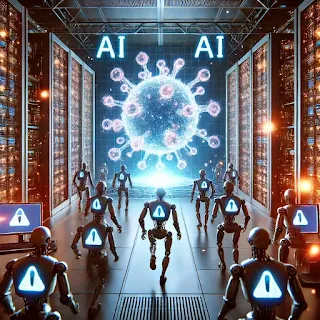AI-Powered Cyber Threats: How Hackers Will Use AI in 2025
Introduction:
Cybersecurity experts are warning that AI-powered cyber threats will become more advanced in 2025. Hackers are now using Artificial Intelligence to automate attacks, bypass security systems, and create highly sophisticated phishing scams.
Recently, a major financial institution reported that an AI-driven cyber attack attempted to manipulate its security protocols in real time. This raises a serious question—can traditional cybersecurity measures keep up with AI-enhanced hacking techniques?
In this article, we’ll explore how AI is being used in cyber threats, the risks it poses, and what can be done to protect against AI-driven cyber attacks.
1. The Rise of AI-Powered Hacking
Cybercriminals are integrating AI into their attacks, making them:
✔ Faster – AI automates cyberattacks, reducing the time required to breach systems.
✔ Smarter – Machine learning allows attacks to adapt in real-time.
✔ Harder to Detect – AI can bypass traditional security measures.
Top AI-Powered Threats Expected in 2025:
- AI-Generated Phishing Emails – Hyper-realistic scams tricking victims with personalized content.
- Autonomous Malware – Self-learning viruses that evolve to avoid detection.
- AI-Powered Deepfakes – Fake videos and voice calls used for fraud.
2. AI in Phishing and Social Engineering Attacks
Traditional phishing relies on mass emails with generic messages, but AI takes it to the next level. Hackers now use AI to:
🔹 Analyze social media and emails to craft highly personalized phishing messages.
🔹 Mimic human writing styles so emails look authentic.
🔹 Automate large-scale scams in real time.
For example, AI-generated phishing emails can now perfectly replicate corporate emails, making them almost indistinguishable from legitimate ones.
3. AI-Powered Malware and Ransomware
AI is enabling malware that thinks and adapts like a human hacker.
How AI-Driven Malware Works:
✔ Evolves in real-time – Learns from cybersecurity defenses and changes tactics.
✔ Avoids detection – Alters code to bypass antivirus software.
✔ Targets specific victims – Identifies high-value targets using AI analysis.
🔸 AI-driven ransomware in 2025 could encrypt data in seconds and demand payment through undetectable automated negotiations.
4. Deepfake Scams and AI-Generated Fraud
AI-generated deepfake technology is now so advanced that fake videos, voice calls, and images are almost impossible to distinguish from real ones.
🔹 Fake CEO voice calls trick employees into transferring money.
🔹 AI-generated scam videos impersonate politicians and public figures.
🔹 Fake job interviews steal sensitive company data.
Cybercriminals can use AI to manipulate voices and facial expressions in real time, making social engineering attacks far more dangerous.
5. Defending Against AI-Powered Cyber Threats
With AI being weaponized, cybersecurity must evolve. How can individuals and businesses protect themselves?
Key Defense Strategies:
✅ AI-Based Cybersecurity – Using AI to detect and block AI-driven threats.
✅ Zero-Trust Security Models – Verifying every access request.
✅ Deepfake Detection Tools – Identifying fake voices and videos.
✅ Employee Training – Raising awareness about AI-powered scams.
As cybercriminals adopt AI, security experts must stay ahead by developing counter-AI defenses.
Conclusion
AI-powered cyber threats are becoming smarter, faster, and more dangerous. By 2025, hackers may use AI to launch fully automated cyberattacks that are nearly impossible to detect. The question is—are we prepared?
Cybersecurity experts must continuously innovate to stay ahead of AI-driven threats. The future of online safety depends on fighting AI with AI.
Final Thoughts: The Battle Between AI and Cybersecurity
The rise of AI in cybersecurity is both exciting and alarming. While AI helps in detecting threats faster, it also gives hackers the ability to launch smarter and more deceptive attacks.
Recently, a small business owner I know fell victim to an AI-generated scam call. The voice sounded exactly like a trusted client, convincing him to share sensitive details. This shows how AI-driven cyber threats are no longer limited to big corporations—they can target anyone.
So, what’s the solution? Staying informed, using multi-layered security, and being cautious of digital interactions is now more important than ever. The battle between AI-powered security and AI-powered hacking is ongoing—but in the end, awareness and adaptation will be our strongest defense.













0 Comments